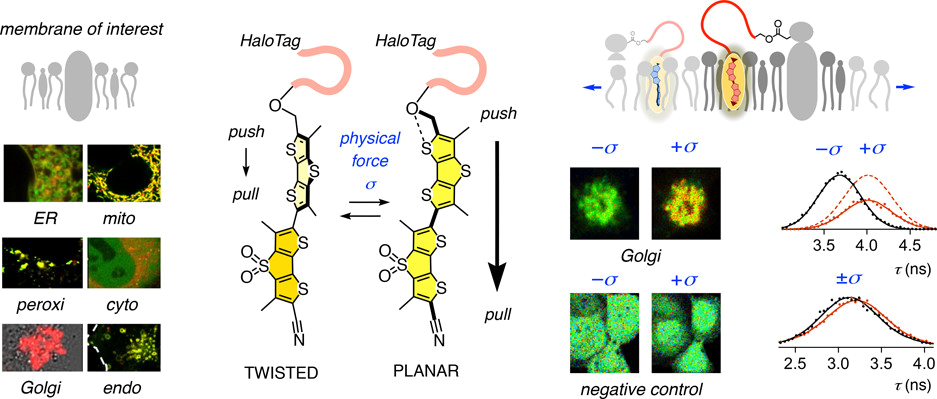- Straková, K.; López-Andarias, J.; Jiménez-Rojo, N.; Chambers, J. E.; Marciniak, S. J.; Riezman, H.; Sakai, N.; Matile, S. “HaloFlippers: A General Tool for the Fluorescence Imaging of Precisely Localized Membrane Tension Changes in Living Cells” ACS Cent. Sci. 2020, 6, 1376-1385

Tools to image membrane tension in response to mechanical stimuli are badly needed in mechanobiology. We have recently introduced mechanosensitive flipper probes to report quantitatively global membrane tension changes in fluorescence lifetime imaging microscopy (FLIM) images of living cells. However, to address specific questions on physical forces in biology, the probes need to be localized precisely in the membrane of interest (MOI). Herein we present a general strategy to image the tension of the MOI by tagging our newly introduced HaloFlippers to self-labeling HaloTags fused to proteins in this membrane. The critical challenge in the construction of operational HaloFlippers is the tether linking the flipper and the HaloTag: It must be neither too taut nor too loose, be hydrophilic but lipophilic enough to passively diffuse across membranes to reach the HaloTags, and allow partitioning of flippers into the MOI after the reaction. HaloFlippers with the best tether show localized and selective fluorescence after reacting with HaloTags that are close enough to the MOI but remain nonemissive if the MOI cannot be reached. Their fluorescence lifetime in FLIM images varies depending on the nature of the MOI and responds to myriocin-mediated sphingomyelin depletion as well as to osmotic stress. The response to changes in such precisely localized membrane tension follows the validated principles, thus confirming intact mechanosensitivity. Examples covered include HaloTags in the Golgi apparatus, peroxisomes, endolysosomes, and the ER, all thus becoming accessible to the selective fluorescence imaging of membrane tension.
DOI: 10.1021/acscentsci.0c00666
open archive unige:140489 • pdf ![]()
